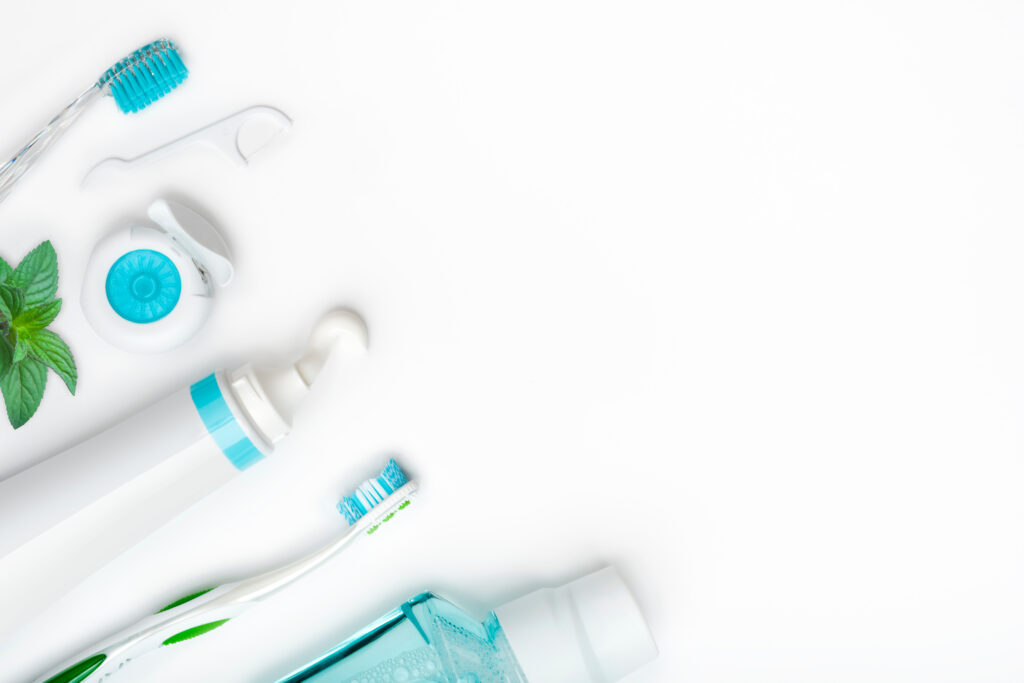This spring, you may want to consider cleaning up your oral health habits to improve your smile and maintain good oral health. Your teeth and smile can reflect your personality, confidence, and overall health. With some simple steps, you can address any oral health concerns and confidently enjoy the upcoming beautiful days.
Out with the old oral hygiene tools and in with the new
Time for a new toothbrush
It is highly recommended to replace your toothbrush once every three months. Other signs that tell you that you need a toothbrush replacement are if you notice the bristles are frayed or worn out or the discoloration of the bristles. Replace if your toothbrush has a strong odour or you have suffered from an illness recently.
Throw out expired products and replace: how to tell if a product is expired.
There are five ways how you can check whether your dental cleaning product is expired. Check for signs of spoilage. Check for signs of mould. Check for changes in taste. Look for a production code. Contact the manufacturer.
Usually, your mouthwash has a shelf life of three years; toothpaste has a shelf life of two years, and tongue cleaners have a shelf life of six months. Toothbrushes and dental floss should be replaced within three months.
Go on a dental hygiene shopping spree
Keeping a few tips in mind will help you choose the right toothbrush and toothpaste.
Choose a toothbrush with soft bristles. Ensure the toothbrush is the right size. Decide if you want electric or manual.
When choosing a toothpaste, pick one withfluoride. Choose one that meets your specific needs. Check for the Canadian Dental Association (CDA) seal of approval. Avoid abrasive toothpaste. Consider a taste you like.
Time to deep clean and sanitize!
Clean toothbrush holder
Toothbrush holders are often damp and provide a breeding ground for bacteria, especially if they are not cleaned regularly. This can lead to the growth of harmful bacteria, which can then be transferred to your toothbrush and, ultimately, to your mouth.
How to sanitize a toothbrush
Sanitizing your toothbrush once a week is recommended to reduce the risk of bacterial buildup. However, some situations may require more frequent sanitizing, such as if you have been sick or if you share your toothbrush with someone else.
To sanitize your toothbrush, first rinse it thoroughly under running water to remove any leftover toothpaste, food particles, or debris. Then soak it in antibacterial mouthwash or hydrogen peroxide for about 15-30 minutes. Be sure to use enough to fully cover the bristles.
Rinse your toothbrush again under running water to remove any remaining disinfectant or debris. Allow your toothbrush to air dry completely before using it again. Avoid storing it in an enclosed container or cover, which can create a moist environment that promotes bacterial growth.
How to sanitize oral appliances
You can follow the same process mentioned above to sanitize your other oral healthcare appliances like aligners, retainers, and dentures.
Create an oral care routine and schedule a dental cleaning
The ideal oral hygiene routine consists of brushing teeth twice a day. Use a soft-bristled toothbrush and fluoride toothpaste. Also, make it a habit of flossing daily and rinsing with mouthwash. Eating a healthy diet, limiting acidic and sugary foods and drinks, and regular dental check-ups and cleanings help. Following these practices can help maintain good oral health, prevent oral health problems, and promote fresh breath.
Additionally, you can practice consistently wearing a mouthguard, using a tongue scraper, and incorporating water flossing.
Dental cleaning is important for preventing cavities and gum disease, freshening breath, detecting oral health problems early, and promoting overall health. Schedule a dental cleaning every six months or more frequently if you have a history of oral health problems.
Kick bad oral health habits to the curb
You ought to let go of bad oral habits like smoking and excessive sugary food consumption to have a healthy smile. Avoid using your teeth for non-chewing purposes, such as using them to open packages, holding keys while your hands are full, or chewing on pen caps.
To clean up your oral health, follow a disciplined oral health care routine, eat a healthy diet, and have a regular dental cleaning. Incorporate additional practices such as tongue scraping and water flossing. Avoid using your teeth for non-chewing purposes to prevent damage.


0 comments on “Time for Spring Cleaning: How to Clean Up Your Oral Health”